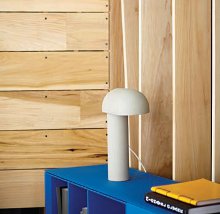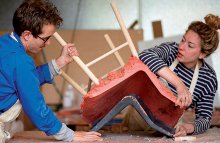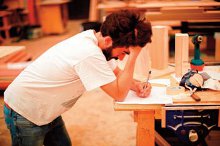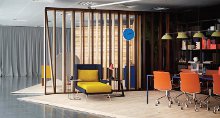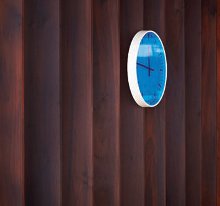Rhyme and reason
23 April 2013The American Hardwood Export Council is focused on giving its promotional strategy ever more technical clout. Mike Jeffree reports.
The Well Proven Chair, a funkily futuristic piece of furniture comprising a US ash base and a body moulded from bioresin and wood residue from the making process, was put up for one of this year's 'designer's Oscars', a Design Museum Design of the Year Award. The chair is one of the results of the Out of the Woods design challenge, set for students at London's Royal College of Art (RCA) by the American Hardwood Export Council (AHEC), and the latter's European director, David Venables, was understandably enthusiastic about its nomination.
"It puts the designers, Marjan van Aubel and James Shaw, and US hardwoods in incredible company," he said. "Other nominees included architect Renzo Piano for London's Shard skyscraper, and designer Thomas Heatherwick for the 2012 Olympics 'petal' cauldron." But AHEC's satisfaction at the Well Proven Chair being mentioned in the same breath as such design luminaries is down to more than the recognition of its creative quality and US hardwood's contribution to it. It's also due to Out of the Woods emerging from the demanding promotional and market education strategy AHEC has been developing to advance the material's wider performance potential.
The organisation already has a long track record of working closely with designers and architects to help them explore the aesthetic possibilities of US hardwood, and encourage its use. But successful as this has been, in terms of the material featuring in high-profile, groundbreaking projects, AHEC has now set itself a still greater challenge. The gauntlet it threw down, Mr Venables boldly told TTJ last year, was that every venture it now gets involved with should include a potent, demonstrable technical aspect.
"Our design projects have never been frivolous," he said. "But given the growing technical sophistication and literacy of the market, and the science and data we can now put behind our message, we decided that we could significantly strengthen the technical criteria and ambition of what we undertake."
The seeds for this strategy were sown by earlier projects, notably the Sclera tulipwood pavilion, devised by architect David Adjaye for the 2008 London Design Festival (LDF).
"David was drawn to tulipwood by its aesthetics," said Mr Venables. "But Sclera was technically innovative too. No-one had exposed the species structurally before, and we worked with Osmose on an oil treatment to enable it to be used externally." The project that really crystallised AHEC's thoughts on the way forward, however, was the Timber Wave. This intricate, but robust 12m lattice arch in laminated US red oak was the star turn of the 2011 LDF, standing outside London's V&A Museum for the duration. It was AHEC's most demanding showcase yet and involved a prestigious trio of partners: architect Amanda Levete of AL_A, engineers Arup and contractor Cowley Timberwork. "It was a technical test-bed for everyone and really opened eyes to US hardwoods' structural potential," said Mr Venables. Since the Timber Wave, AHEC has pursued its new thrust, meshing the creative and technical, with determination. Out of the Woods, for starters, really picked up the gauntlet and ran with it. The project, devised by Mr Venables with RCA tutor Sebastian Wrong, was about far more than design. As part of its wider environmental remit, AHEC had previously commissioned consultancy PE International to undertake a major life cycle analysis (LCA) of US hardwoods. The Out of the Woods students learned about the LCA process then, besides coming up with a total of 12 chairs in US species that performed and looked good, they had to use PE's findings to shape the design and development process to minimise their end products' environmental impacts. They worked together with manufacturer Benchmark Furniture, which made prototypes of the chairs for the 2012 LDF and helped refine the designs through the production process. This built on PE's cradle to factory gate LCA to give a complete cradle to grave environmental profile for each chair.
Completing the creative-technical circle, AHEC also published a beautifully designed book on the initiative, while the RCA commissioned writers to pen stories and poems about the chairs' imagined lives.
"This was a hugely satisfying project, with potentially far-reaching repercussions" said Mr Venables. "The RCA students are the lead designers of the future and will take this experience of timber, its performance and environmental credentials into their careers."
Benchmark founder Sean Sutcliffe was equally enthused. "It was inspirational, not just in terms of working with the students, but also the science," he said. "We now aim to develop a furniture range underpinned by LCA."
Longer-term life cycle potential
Mr Venables said Benchmark's ambition showed that Out of the Woods, and projects like it, have longer-term consequences still.
"To achieve their carbon and wider environmental goals, we are ever more likely to see governments use legislation and tax to increase the cost of high eco impact products and materials, making those incorporating LCA, and the Environmental Product Declarations it can feed into, even more attractive," he said. "The higher the green rating, the cheaper products will be, so it will make increasing sense for business to go this route."
Ultimately the LCA data amassed by AHEC, and used by the students, could also feed into software tools for modelling product and building carbon performance.
"When you think construction alone is responsible for 40% of UK carbon emissions, this is a vision that has to develop," said Mr Venables. "We're encouraging industry to pick up on the science and benefit and, provided the timber sector stands shoulder to shoulder, we can really turn it into a business opportunity."
Another key recent technical focus for AHEC, both to broaden US hardwoods' appeal and application, has been use of heat treatment (see pp22-23). It is not, of course, a novelty, with several American mills already marketing a range of heat-treated species. But working with Neil Summers, of Timber Dimension, AHEC has been further evaluating its use with different varieties and its market potential.
Opening up new markets
According to Mr Summers, heat treatment isn't applicable to all US species, but works with most best sellers: ash, tulipwood, birch, maple, red oak, hickory and pecan. The process improves durability, moisture and fungal resistance and even thermal performance, opening up exterior joinery possibilities for species previously limited to interior use.
UK interest in heat-treated material, added Mr Summers, seems to be growing.
"Joiners who use it are soon won over, as it machines so well and requires little denibbing," he said. "In fact, I've been invited to give a presentation on it at the British Woodworking Federation Members' Day."
AHEC has also showcased heat-treated timber to the design and architectural community, first in the form of the multi-species Infinity Bench it commissioned from designer Martino Gamper for the 2012 LDF. More recently, heat-treated tulipwood combined with untreated in an exhibition structure for design magazine Wallpaper's "Office of the Future" event. Called "Octopus", it was designed by architect Adam Khan and made by fabricator Adam Kershaw, comprising 180 pieces in a framework delineating three workspace displays.
"What this highlighted is that heat-treated timber also has distinctive design appeal," said Robert Morgan, of the tulipwood supplier Morgan Timber. "The architect was particularly struck by the contrast between the richer heattreated material and the lighter untreated."
Also now very much in AHEC's sights, following on from the Timber Wave, is greater structural application of hardwoods, notably in engineered products. These may traditionally be the preserve of softwoods, but following work with a leading structural engineer, Mr Venables believes there is major scope for a change of mindset.
"Hardwood laminated products make more of the resource because they can use lower grades for high spec applications, and hardwood's superior strength-to-weight ratio to softwood means using less material for the same job," he said. "It has the potential to be a valuable additional structural option."
Underlining AHEC's conviction, engineered hardwood will be used for its 2013 LDF project, on which it is teaming with Arup and Alex de Rijke of dRMM architects. Once more a blend of design and technology, the showpiece will be loosely based on a famous, as yet undisclosed, artwork and will be so robust people will not only be able to walk around and through, but possibly up and over it.
While declining at this point to divulge more technical detail, Mr Venables said it would be bigger and have even more "longer-term practical significance" than the Timber Wave, with the whole project also life cycle profiled. It will also get even more exposure. The still secret location will be an iconic spot "with among the highest pedestrian footfall in London".
According to Mr Venables, the project will make a big impact and truly reflect AHEC's vision and ambition for US hardwoods.
"We don't want to rule the world, but we do aim to be a more important part of the equation," he said.
